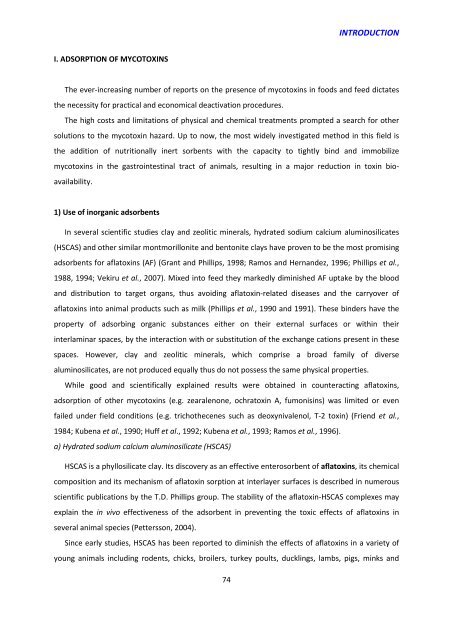Effet chez le porcelet d'une exposition à un régime co-contaminé en ...
Effet chez le porcelet d'une exposition à un régime co-contaminé en ...
Effet chez le porcelet d'une exposition à un régime co-contaminé en ...
You also want an ePaper? Increase the reach of your titles
YUMPU automatically turns print PDFs into web optimized ePapers that Google loves.
INTRODUCTIONI. ADSORPTION OF MYCOTOXINSThe ever-increasing number of reports on the pres<strong>en</strong>ce of my<strong>co</strong>toxins in foods and feed dictatesthe necessity for practical and e<strong>co</strong>nomical deactivation procedures.The high <strong>co</strong>sts and limitations of physical and chemical treatm<strong>en</strong>ts prompted a search for othersolutions to the my<strong>co</strong>toxin hazard. Up to now, the most widely investigated method in this field isthe addition of nutritionally inert sorb<strong>en</strong>ts with the capacity to tightly bind and immobilizemy<strong>co</strong>toxins in the gastrointestinal tract of animals, resulting in a major reduction in toxin bioavailability.1) Use of inorganic adsorb<strong>en</strong>tsIn several sci<strong>en</strong>tific studies clay and zeolitic minerals, hydrated sodium calcium aluminosilicates(HSCAS) and other similar montmorillonite and b<strong>en</strong>tonite clays have prov<strong>en</strong> to be the most promisingadsorb<strong>en</strong>ts for aflatoxins (AF) (Grant and Phillips, 1998; Ramos and Hernandez, 1996; Phillips et al.,1988, 1994; Vekiru et al., 2007). Mixed into feed they markedly diminished AF uptake by the bloodand distribution to target organs, thus avoiding aflatoxin-related diseases and the carryover ofaflatoxins into animal products such as milk (Phillips et al., 1990 and 1991). These binders have theproperty of adsorbing organic substances either on their external surfaces or within theirinterlaminar spaces, by the interaction with or substitution of the exchange cations pres<strong>en</strong>t in thesespaces. However, clay and zeolitic minerals, which <strong>co</strong>mprise a broad family of diversealuminosilicates, are not produced equally thus do not possess the same physical properties.Whi<strong>le</strong> good and sci<strong>en</strong>tifically explained results were obtained in <strong>co</strong><strong>un</strong>teracting aflatoxins,adsorption of other my<strong>co</strong>toxins (e.g. zeara<strong>le</strong>none, ochratoxin A, fumonisins) was limited or ev<strong>en</strong>fai<strong>le</strong>d <strong>un</strong>der field <strong>co</strong>nditions (e.g. trichothec<strong>en</strong>es such as deoxyniva<strong>le</strong>nol, T-2 toxin) (Fri<strong>en</strong>d et al.,1984; Kub<strong>en</strong>a et al., 1990; Huff et al., 1992; Kub<strong>en</strong>a et al., 1993; Ramos et al., 1996).a) Hydrated sodium calcium aluminosilicate (HSCAS)HSCAS is a phyllosilicate clay. Its dis<strong>co</strong>very as an effective <strong>en</strong>terosorb<strong>en</strong>t of aflatoxins, its chemical<strong>co</strong>mposition and its mechanism of aflatoxin sorption at interlayer surfaces is described in numeroussci<strong>en</strong>tific publications by the T.D. Phillips group. The stability of the aflatoxin-HSCAS <strong>co</strong>mp<strong>le</strong>xes mayexplain the in vivo effectiv<strong>en</strong>ess of the adsorb<strong>en</strong>t in prev<strong>en</strong>ting the toxic effects of aflatoxins inseveral animal species (Pettersson, 2004).Since early studies, HSCAS has be<strong>en</strong> reported to diminish the effects of aflatoxins in a variety ofyo<strong>un</strong>g animals including rod<strong>en</strong>ts, chicks, broi<strong>le</strong>rs, turkey poults, ducklings, lambs, pigs, minks and74

















